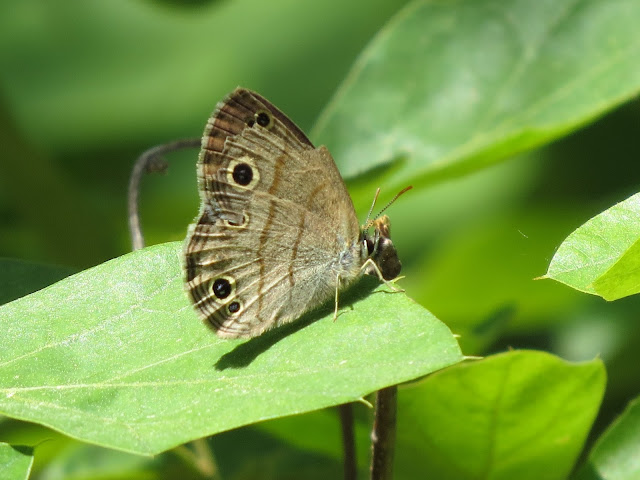Karner Blue butterflies require wild lupine as a host plant (on which they lay their eggs and whose flowers the resulting caterpillars will eat for food) in a pine barrens habitat. In 1992, the Karner Blue was voted to be the state butterfly of NH. However, by 1999, there were none left in the state. In 2000, the state of NY sent butterflies to help restore the population in NH, and since then, the population reached its highest count in 2010, when there were 2400 butterflies. Last year they estimated there were about 1,500. They hope to eventually maintain about 3000 butterflies for five straight years and expect to achieve this goal by 2017. NH's program is so successful, they now export caterpillars to other states that are also working to restore lost populations.
Michael spotted the first Karner Blue very near where we posed for our group photo, so we were immediately off to a good start (because there are no guarantees of sightings)!
Karner Blue
Wild Lupine
Eastern Pine Elfin
Dusted Skipper
more Wild Lupine
Silvery Blue
Karner Blue
Frosted Elfin
Karner Blue
Little Wood Satyr
Karner Blue
Juvenal's Duskywing
Karner Blue
American Copper
Indian Skipper (life butterfly for me!)
Karner Blue
I thought this was the prettiest one, posing on the white flower and giving us glimpses of its beautiful blue interior wings.
Indian Skippers courting
After lunch, a smaller group of us took an extended trip to Ponemah Bog in Amherst, NH. We only saw two additional butterflies here, but we all enjoyed the bog habitat and hope to return for Bog Coppers and Grass Pink orchids!
Red-Spotted Purple
Sundew
My favorite part of my 2nd visit to Ponemah Bog was having Rosemary point out these Sundew plants. They were so low to the ground and so small that I didn't notice they were sundew. They are carnivorous but so beautiful!
The suns (circles) are surrounded with tentacles (rays) that end in sticky secretions (dew) that attract small insects. The secretions perform multiple functions: attracting prey, trapping prey, and then providing the enzymes to aid the digestion process. Either exhaustion or suffocation results in death of the prey within about 15 minutes. The enzymes dissolve the insect and the nutrient "soup" is then absorbed through the plant's surface.
Purple Pitcher Plants
Song Sparrow with large caterpillar
Indian Skipper?
Downy Woodpecker
(Thanks, Josh, for pointing out the spots on the tail which clinch this ID.)
Hairy Woodpecker?
(Thanks, Josh, for pointing out the spots on the tail which clinch this ID.)
Eastern Towhee
Pink Ladyslipper
closeup































Dawn: I can see some black spots on the white tail feathers of the woodpecker. According to All About Birds, "Hairy Woodpeckers also have [...] in most populations, completely white outer tail feathers". So, I'd say this one is likely a Downy.
ReplyDelete